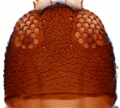Scopaeothrips bicolor
Recognition data
Distinguishing features
Females fully winged, also females and males with wings shorter than thorax width. Head and thorax brown, abdomen yellow with paired dark spots on tergites II � VIII; tarsi yellow, mid and hind femora and tibiae bicolored; forewings pale. Head about as wide as long; dorsal surface tuberculate-reticulate, with three pairs of short, translucent capitate setae; maxillary stylets one third of head width apart. Antennae 8-segmented; segment III smaller than II or IV, without sensorium; segment IV with two sensoria; segments VI � VIII broadly joined. Pronotum with five pairs of short, translucent, fan-shaped setae, also one pair of similar setae medially in front of posterior margin; surface tuberculate. Metanotum densely tuberculate. Forewing parallel sided; no duplicated cilia. Abdominal tergites II � VII with one pair of sigmoid wing-retaining setae, these are reduced to minor setae in short-winged individuals; paired dark areas on tergites are finely tuberculate; tergite IX setae S1 shorter than width of tube.
Related and similar species
Only two species are placed in Scopaeothrips, both living on Cactaceae of the genus Opuntia. The second species, S. unicolor Hood, has antennal segment VII narrowed at the base (Mound & Marullo, 1996).
Taxonomic data
Current valid name
Scopaeothrips bicolor (Hood)
Original name and synonyms
Rhopalothrips bicolor Hood, 1912: 72
Family placement
Phlaeothripidae, Phlaeothripinae
Biological data
Life history
Breeding on green tissues rather than in flowers.
Host plants
Cactaceae including Opuntia and Rebutia.
Tospoviruses vectored
None
Crop damage
None
Distribution data
Area of origin
Probably Central or Western America.
Distribution
California, Arizona, Texas, Mexico.





